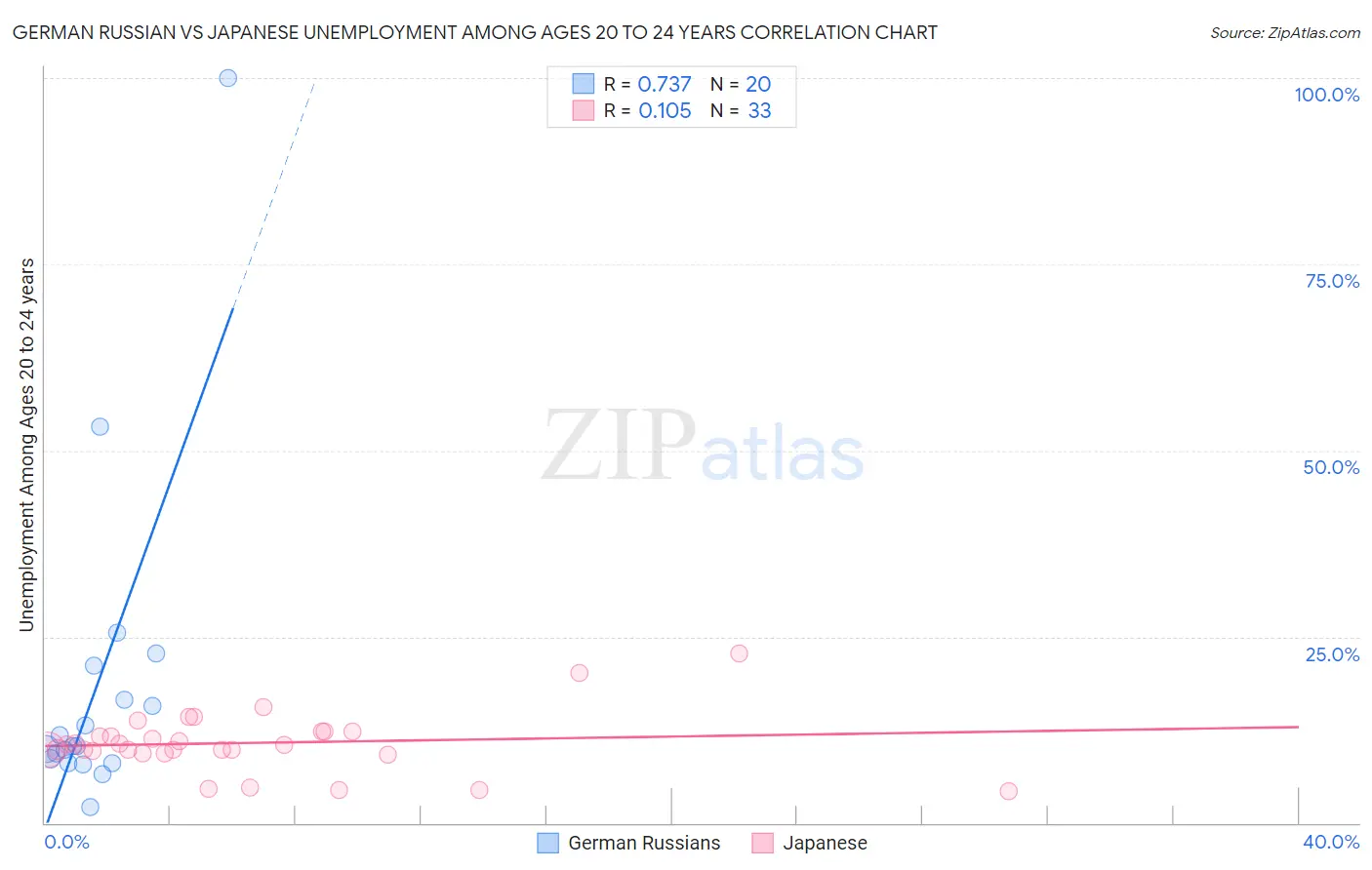German Russian vs Japanese Unemployment Among Ages 20 to 24 years
COMPARE
German Russian
Japanese
Unemployment Among Ages 20 to 24 years
Unemployment Among Ages 20 to 24 years Comparison
German Russians
Japanese
10.1%
UNEMPLOYMENT AMONG AGES 20 TO 24 YEARS
92.4/ 100
METRIC RATING
113th/ 347
METRIC RANK
10.0%
UNEMPLOYMENT AMONG AGES 20 TO 24 YEARS
95.4/ 100
METRIC RATING
98th/ 347
METRIC RANK
German Russian vs Japanese Unemployment Among Ages 20 to 24 years Correlation Chart
The statistical analysis conducted on geographies consisting of 95,272,283 people shows a strong positive correlation between the proportion of German Russians and unemployment rate among population between the ages 20 and 24 in the United States with a correlation coefficient (R) of 0.737 and weighted average of 10.1%. Similarly, the statistical analysis conducted on geographies consisting of 246,004,323 people shows a poor positive correlation between the proportion of Japanese and unemployment rate among population between the ages 20 and 24 in the United States with a correlation coefficient (R) of 0.105 and weighted average of 10.0%, a difference of 0.49%.

Unemployment Among Ages 20 to 24 years Correlation Summary
| Measurement | German Russian | Japanese |
| Minimum | 2.1% | 4.3% |
| Maximum | 100.0% | 22.8% |
| Range | 97.9% | 18.5% |
| Mean | 18.5% | 10.7% |
| Median | 10.3% | 10.5% |
| Interquartile 25% (IQ1) | 8.3% | 9.5% |
| Interquartile 75% (IQ3) | 18.8% | 12.3% |
| Interquartile Range (IQR) | 10.5% | 2.8% |
| Standard Deviation (Sample) | 22.0% | 4.0% |
| Standard Deviation (Population) | 21.5% | 3.9% |
Demographics Similar to German Russians and Japanese by Unemployment Among Ages 20 to 24 years
In terms of unemployment among ages 20 to 24 years, the demographic groups most similar to German Russians are Northern European (10.1%, a difference of 0.030%), Immigrants from Indonesia (10.1%, a difference of 0.040%), Immigrants from Spain (10.1%, a difference of 0.10%), Immigrants from Latvia (10.1%, a difference of 0.11%), and Filipino (10.1%, a difference of 0.11%). Similarly, the demographic groups most similar to Japanese are Fijian (10.0%, a difference of 0.020%), Immigrants from France (10.0%, a difference of 0.030%), Laotian (10.0%, a difference of 0.060%), Immigrants from Argentina (10.0%, a difference of 0.10%), and Slavic (10.0%, a difference of 0.16%).
| Demographics | Rating | Rank | Unemployment Among Ages 20 to 24 years |
| Scotch-Irish | 96.2 /100 | #95 | Exceptional 10.0% |
| Thais | 96.2 /100 | #96 | Exceptional 10.0% |
| Slavs | 96.1 /100 | #97 | Exceptional 10.0% |
| Japanese | 95.4 /100 | #98 | Exceptional 10.0% |
| Fijians | 95.3 /100 | #99 | Exceptional 10.0% |
| Immigrants | France | 95.2 /100 | #100 | Exceptional 10.0% |
| Laotians | 95.1 /100 | #101 | Exceptional 10.0% |
| Immigrants | Argentina | 94.9 /100 | #102 | Exceptional 10.0% |
| Irish | 94.3 /100 | #103 | Exceptional 10.0% |
| Immigrants | Chile | 94.0 /100 | #104 | Exceptional 10.0% |
| Immigrants | Hungary | 94.0 /100 | #105 | Exceptional 10.0% |
| Pennsylvania Germans | 93.9 /100 | #106 | Exceptional 10.0% |
| Iroquois | 93.4 /100 | #107 | Exceptional 10.1% |
| Immigrants | Latvia | 93.2 /100 | #108 | Exceptional 10.1% |
| Filipinos | 93.2 /100 | #109 | Exceptional 10.1% |
| Immigrants | Spain | 93.1 /100 | #110 | Exceptional 10.1% |
| Immigrants | Indonesia | 92.7 /100 | #111 | Exceptional 10.1% |
| Northern Europeans | 92.7 /100 | #112 | Exceptional 10.1% |
| German Russians | 92.4 /100 | #113 | Exceptional 10.1% |
| Ottawa | 90.8 /100 | #114 | Exceptional 10.1% |
| Immigrants | Morocco | 90.5 /100 | #115 | Exceptional 10.1% |